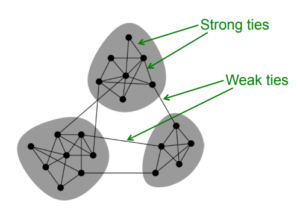Motivation
Many of us at the moment are nearing or in our last year of university. Now we must consider the problem at hand of figuring out what to do next; it can be pursuing further education, but most of us will likely be trying to seek full-time work. With the recession and more competition for roles, people will have to start finding alternate ways how to seek roles the most optimally to be able to land the role successfully.
Analysis
We tend to flock to people who are similar to us. People from the same location, background, gender, and race tend to be friends because it is a lot easier to find those connections. These would be smaller and stronger tied communities. When people with a lot more differences become connected, they have to “transcend” their differences and find a common connection to build upon. These people are called “social brokers”, as they bridge that gap and connect unconnected groups, essentially creating a weak tie between two unlikely communities (Kelly).
From a recent study done by LinkedIn, and as mentioned in our lecture about weak ties, it turns out that people that we only know slightly can help us “gain access to job networks that stretch into unexpected areas”. People that we would only know slightly can become our “social broker” and help connect us to the rest of their community. We learnt that weak ties have access to different parts of the network, allowing there to be a new flow of information from people that are different from us and have different experiences. This enables us to find people and opportunities that we would otherwise not know about (Anders).

We love our friends, but they would not be the most helpful in this aspect, as they would have the same knowledge and connections that we do – strong ties in a network give redundant information as we are all connected to relatively the same things. Someone of a higher social status would have more connections and influence. Someone from a different industry can give more perspective on their career journey. Someone from a different age group can also give their expertise (Anders).
In the end, there has to be some sort of connection first in order for the weak tie to count as a weak tie – you wouldn’t have a connection to a total stranger! There needs to be some interpersonal relationship, whether or not you are close with them.
Conclusion
Looks like we will have to be getting out of our comfort zone! Instead of relying on friends and the close network that we have, we should be focusing on finding or becoming “social brokers” who can help bridge the gap and reach places that we would not be able to on our own. Personally, I hate networking as I find it difficult to hold conversations with people I just met. But, in order to connect the unconnected groups, it needs to be done.
Reference
Anders, George. “Using ‘weak ties’ to aid your job hunt: what a giant study can teach us.” LinkedIn, LinkedIn, Sep. 15, 2022, https://www.linkedin.com/pulse/using-weak-ties-aid-your-job-hunt-what-giant-study-can-george-anders/.
Kelly, Jane. “What are ‘social brokers’ and ‘weak ties?’ and what do they mean in the job market?” University of Virginia, UVA Today, Oct. 10, 2022, https://news.virginia.edu/content/what-are-social-brokers-and-weak-ties-and-what-do-they-mean-job-market.